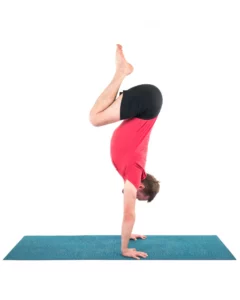Yoga Cues for Beginners: Teaching Older Adults

Yoga cues are a powerful way to help beginners understand and feel safe in the practice. Especially when it comes to teaching older adults, effective cueing can play a crucial role in guiding these students through their practice, helping them build confidence and avoid injury. This article explores key strategies and yoga cues for beginners, specifically designed to support older adults as they begin their yoga journey.
Why are Yoga Cues so Important for Older Beginners?

Older adults may have different physical capabilities, health considerations, and learning preferences than younger practitioners. For instance, older beginners might face challenges such as stiffness, joint instability, or balance concerns, which require specific instructions that are easy to follow and understand. Tailored cueing can help to empower older students by promoting body awareness and confidence, allowing them to safely explore their abilities within the boundaries of their physical limitations.
Moreover, thoughtful cueing can foster a sense of inclusivity, allowing older adults to feel supported and encouraged in their practice, regardless of their starting point. This mindful approach not only enhances the overall effectiveness of the yoga session but also contributes to the student’s long-term well-being by reducing the risk of injury and promoting a sustainable, enjoyable practice. Careful attention to cueing also builds trust between the yoga teacher and the students, creating a supportive environment where older adults feel comfortable progressing at their own pace.
Understanding Types of Yoga Cues for Beginners
Precise, clear, and compassionate cues are essential in creating a positive and accessible yoga experience for older beginners. But which types of cues should you include in your classes? Here are a few categories of cues that can be especially beneficial in a practice for older beginners:
-
Breath Cues

Nearly every effective instruction in yoga begins with the breath, so if you want to cue older beginners, consider starting with this type of cue. Breath cues guide students on how to breathe in a yoga pose. For example, you may cue students to “breathe into areas of tension” to encourage them to release stress in the body. Or in restorative postures, you may instruct students to “breathe into the belly” to promote relaxation.
Once older beginners feel comfortable with how to breathe, you can begin cueing when to breathe in yoga postures. To instruct a simple Vinyasa flow you may say, “Inhale as you lift your arms overhead; exhale as you lower your arms alongside you.” Synchronizing movement with breath can encourage a calm, focused practice.
-
Alignment Cues

This category of cues focuses on the positioning of the body in a pose. Alignment cues help students understand how to engage their muscles and joints correctly, reducing the risk of injury. For example, you may instruct students to keep their “pelvis in neutral” in Mountain Pose (Tadasana) or to “stack the knee above the ankle” in a Low Lunge Pose (Anjaneyasana). For older beginners, guidance on alignment may include time for questions to ensure students understand and can apply the instructions.
-
Energetic Cues

While energetic cues may be slightly harder for beginning students to grasp, they are my favorite category of cues because once students do understand them, everything about the posture falls into place. Energetic cues describe the feeling or intention behind a movement or pose. Examples include instructing students to “ground down through your feet” or “let your heart open toward the sky.” Energetic cues can help older students connect more deeply with their practice on an embodied and emotional level.
-
Silence

Sometimes, the best cue is no cue at all. This is an often-forgotten category of cueing, but it is incredibly important for encouraging the integration of the practice. Allowing moments of silence gives students the space to explore a pose on their own and internalize their experience. For older beginners, silence can also be a powerful tool for building confidence as they learn to trust their bodies. For this reason, it’s important to include pauses in more places in the practice than just Savasana (Relaxation Pose). An opening minute of meditation or a Yin or restorative posture can be great places to include silence in practice for older beginners.
5 Important Guidelines for Cueing Older Beginners
-
Start by Cueing the Breath
It’s worth reiterating that breath is the foundation of yoga. Starting with breath cues can help students center themselves, reduce anxiety, and create a sense of rhythm in their practice. When teaching older beginners, consider offering breath cues that emphasize a slower, more controlled pace. Encourage students to breathe diaphragmatically and remind them that it’s okay to rest and focus on their breath if they feel overwhelmed. By prioritizing breath cues, you create a calm and supportive environment that invites students to mindfully connect with their bodies.
-
Simplify Your Language

Clear, simple language is key when cueing older beginners. If you’re an anatomy buff or if you love Sanskrit, you don’t have to stop using your advanced vocabulary altogether. But it is important that you fully explain terminology beginning students might be unfamiliar with. In addition, it can be helpful to include descriptive language that older beginners can easily visualize. For example, instead of saying, “Engage your core,” you might instruct, “Imagine drawing your belly button toward your spine as if you’re zipping up a tight pair of jeans.” This imagery makes the cue more accessible and easier for beginners to understand and apply.
Similarly, it’s important to break your cues down into small, manageable steps. Consider cueing one action at a time, allowing students to fully integrate each instruction before moving on to the next. This approach not only makes the practice more accessible but also helps build confidence as students feel successful in following your guidance.
-
Offer Non-Hierarchical Cues
In yoga, there can be a tendency to view certain poses as “better” or more advanced than others. However, this mindset can be discouraging for older beginners who may not yet have the strength, flexibility, or balance to master those poses. Instead of presenting modifications as lesser options, offer them as equally valuable variations.
For example, when teaching a pose like Downward Facing Dog Pose (Adho Mukha Svanasana), you might cue the option to practice the pose against a wall, framing this variation as an option to explore the pose in a way that feels best for the student’s body. This non-hierarchical approach helps create an inclusive environment where all students feel empowered to practice at their own level.
-
Cue the Use of Props

Props can be invaluable tools for older beginners, providing support, stability, and comfort as they explore new poses. However, some students may feel self-conscious about using props, seeing them as a sign of weakness or inability. As a teacher, it’s important to normalize and encourage the use of props in your cueing.
When introducing a pose, offer cues that include the use of props right from the start. For example, you may say, “Place a block under your hand for support as you reach into Triangle Pose (Trikonasana),” or “Use a blanket under your knees in Tabletop Pose (Bharmanasana) if you tend to experience knee pain.” By incorporating props into your initial instructions, you help students view them as an integral part of the practice rather than an afterthought.
-
Break Down the Fourth Wall: Cue Based on What You See
Teaching yoga to older beginners isn’t just about giving instructions—it’s also about creating a dialogue. Encourage your students to ask questions, share their experiences, and let you know how they’re feeling throughout the practice. This open communication helps you better understand their needs and adapt your cueing accordingly.
As you teach, it’s also important to pay attention to the way your students move. Observe how they respond to your cues and make adjustments based on what you see. For example, if you notice that several students are struggling with balance in a particular pose, you might offer a cue to use a wall for support or suggest a different variation.
Breaking down the fourth wall also means being flexible in your teaching approach. If a cue isn’t resonating with your students, don’t be afraid to try a different one. Remember that each class is a unique experience, and your ability to adapt and respond to your students in real-time is one of the most valuable skills you can bring to your teaching.
Refining Your Approach: Final Thoughts on Effective Cueing for Older Beginners
Cueing for older beginners requires a blend of clarity, compassion, and creativity. By refining our cueing techniques and embracing a more inclusive approach, we can help older beginners discover the joy and benefits of yoga, fostering a lifelong connection to this transformative practice.
Also, read...
Working with the Fascial Network: The Art of Self-Myofascial Release
Apr 10 – By: YogaU Staff
Simplify Your Yoga Cues to Increase Their Power
Mar 05 – Charlotte Bell
Related courses
Breath as Medicine: Yogic Breathing for Vital Aging
With Doug Keller
Yoga and Myofascial Release: Releasing Chronic Tension with the Bodymind Ballwork Method
With Ellen Saltonstall

Lacey Ramirez writes for YogaUOnline and is an RYT-500 & ERYT-200 yoga teacher, global health researcher, and writer based in St. Louis. Through her work, she seeks to make yoga accessible, inclusive, and equitable.
Lacey discovered yoga as a tool for centering during her years as a competitive runner. Since then, yoga has served as a way to connect with her body throughout her experience of pregnancy and parenthood. She teaches because she hopes others can use this sacred practice for calming, healing, and transformation.
As a yoga teacher, Lacey specializes in teaching restorative, Yin, prenatal, and trauma-informed Vinyasa yoga. She has also completed birth doula and prenatal/postnatal barre certifications and trainings. Additionally, she holds a Masters of Science in Global Health and Population from Harvard T.H. Chan School of Public Health. To learn more and connect, visit her website laceyramirez.com
Recent articles
Warrior I Pose: 5 Strengthening Variations
Jul 02 – Bridget Frederick, eRYT 500
4 Ways to Practice Locust Pose
Jun 30 – Baxter Bell, MD, eRYT 500, C-IAYT
Deepening Your Home Yoga Practice: An Interview with Judith Hanson Lasater
Jun 30 – staff writer YogaUOnline
Categories
Upcoming courses
Breath as Medicine: Yogic Breathing for Vital Aging
With Doug Keller
Yoga and Myofascial Release: Releasing Chronic Tension with the Bodymind Ballwork Method
With Ellen Saltonstall
JOIN NOW!
Recent articles
Almost there...
Sorry, we couldn't find anything...
Yoga Practice Tips
Warrior I Pose: 5 Strengthening Variations
Warrior I Pose (Virabhadrasana I) is an excellent pose for strengthening your whole back…
Jul 02 – Bridget Frederick, eRYT 500
Pose Library
4 Ways to Practice Locust Pose
Locust Pose (Salabhasana) is a simple backbend that strengthens the entire back of your…
Jun 30 – Baxter Bell, MD, eRYT 500, C-IAYT
Yoga Practice Tips
Deepening Your Home Yoga Practice: An Interview with Judith Hanson Lasater
In this interview with YogaUOnline, renowned yoga teacher Judith Hanson Lasater speaks about a subject very…
Jun 30 – staff writer YogaUOnline



